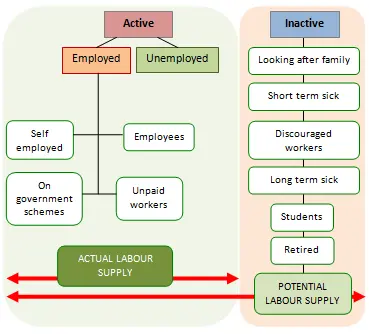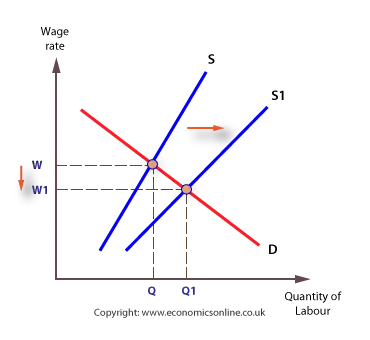
Supply of labour
Labour supply in a competitive market
The labour supply is defined as the number of workers willing and able to work, multiplied by the hours they are willing and able to work. It is determined by:
The wage rate
The higher the wage rate, the more labour is supplied, which means the supply curve of labour will slope upwards. A worker’s wage, along with any bonus, provides the main pecuniary (monetary) benefit from working.

Factors other than wages will shift the supply curve to the left or right. These factors include:
The size of the working population
The working population is the number of people of working age (16 – 60 for women and 16 – 65 for men) who are willing and able to work. The size of the working population is influenced by the retirement and school leaving ages, migration, and numbers staying on at University.
Migration
Migration can have a considerable impact on the labour market. Migrants tend to be of working age, and while the general effect is to increase the supply of labour at all wage rates, migration especially affects supply at lower wage rates. This is because migrants tend to come from low wage economies, with average wages often far below the minimum wage in the UK.
People’s preferences for work
If people prefer more work, the supply of labour increases. Preferences can be influenced by a range of factors including changes in the ‘cost’ of working, such a subsidised childcare, and non-wage benefits (advantages) of working.
Net advantages of work
As well as the wage rate, decisions to increase or decrease labour supply are influenced by non-monetary (non-pecuniary) advantages, such as changes in working conditions, job security, holiday entitlement, promotion prospects, and other pyschological benefits of work. Improvements in these benefits will shift the labour supply curve to the right.
Work and leisure
For many, part-time work is an increasingly attractive option given the advantages of increased leisure. Early retirement is also a factor affecting labour supply.
An individual’s decision to supply labour is greatly affected by the choice between work and leisure. Given that time is fixed, work and leisure are substitutes for each other.
The choice between work and leisure can be affected by a number of factors, including:
- Age – older workers often gain more utility from leisure.
- Direct taxes – higher income tax rates may increase the utility of leisure and reduce the labour supply.
- Dependents – having children may increase the utility of work, and increase the labour supply.
- Non-work income – some individuals can retire from the labour market because they have company pensions which may be received before state pensions, which are available for men at 65 and women at 60. Non-work income can come in the form of cash benefits, such as the Job Seeker’s Allowance, and benefits-in-kind, such as subsidised travel cards.
Individual labour supply
The supply curve for an individual cannot continue to slope upwards indefinitely. Labour market theory suggests it will initially slope upwards, and then bend backwards. Up to a wage rate of W1, the relative price of leisure increases, and workers will look to switch from leisure to work. In other words there is a strong substitution effect as wages start to rise. Hence, the supply curve slopes upwards to point L.

However, beyond W1, the income effect begins to dominate and further rises in money wages, which increase real income, mean that less work is required to achieve the same level of real income.
Length of training of workers
If workers need lengthy training, the effective supply of labour is less in the short run.
Barriers to entry
Barriers to entry into the labour market, such as the strict requirement for qualifications, will make the supply of labour less than it would be with no barriers.
Trade Unions
A trade union is an organisation that aims to protect the interests of workers. Around 30% of UK employees are members of unions, with women more likely to be in a union than men. Union membership has fallen steadily over the last 20 years.
Unions can affect the supply of labour in three ways.
- Firstly, unions can attract workers into the labour market because of the benefits of becoming a member. This will shift the supply curve to the right.
- Secondly, unions exert control over the labour supply and can withdraw labour by limiting working hours or going on strike. A strike will shift the supply curve of labour to the left.
- Thirdly, by influencing wages through collective bargaining the supply curve for unionised workers is more inelastic than one for non-unionised workers.
Go to: Unite – The UK’s largest trade union
Read more on trade unions
Tax and benefit incentives and disincentives
Tax and benefit rates can lead to increases and decreases in the effective labour supply. When income taxes are excessive and benefits too generous, a stay-at-home culture may be encouraged.
Labour subsidies
If the government gives a subsidy to workers to look for work, or to train, then the supply of labour will increase, and the supply curve will shift to the right.
The actual and potential labour supply
The actual labour supply includes those workers who are both willing and able to supply their labour, including the unemployed. The potential labour supply also includes those who, for one reason or another, are currently inactive.

Source: www.statistics.gov
The supply curve of labour in a perfectly competitive market
In a perfectly competitive labour market, where the wage rate is determined in the industry, rather than by the individual firm, each firm is a wage taker. This means that the actual equilibrium wage will be set in the market, and the supply of labour to the individual firm is perfectly elastic at the market rate.
Equilibrium wage in the labour market, and supply for the individual firm.

Labour supply for the whole market is assumed to be positively related to the wage rate, and the market supply curve slopes upwards.
Labour supply can change under a number of circumstances, including changes in:
- The length of the working week.
- Participation rates.
- Demographic factors, such as migration, and changes in the age structure of the population.
- Qualifications and skills required.
- The length of training.
Shifts in the supply curve
The labour supply curve will shift its position following a change in a non-wage determinant of suppy, as listed above.

Go to equilibrium wage rate and employment


